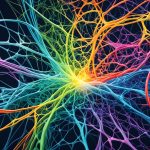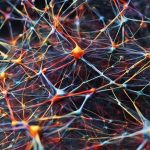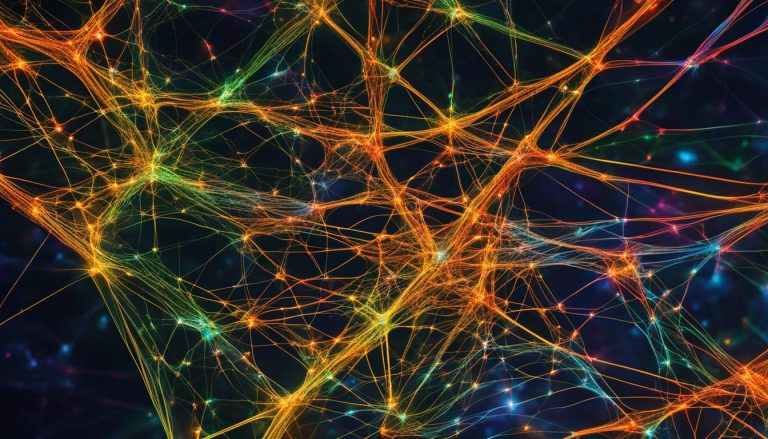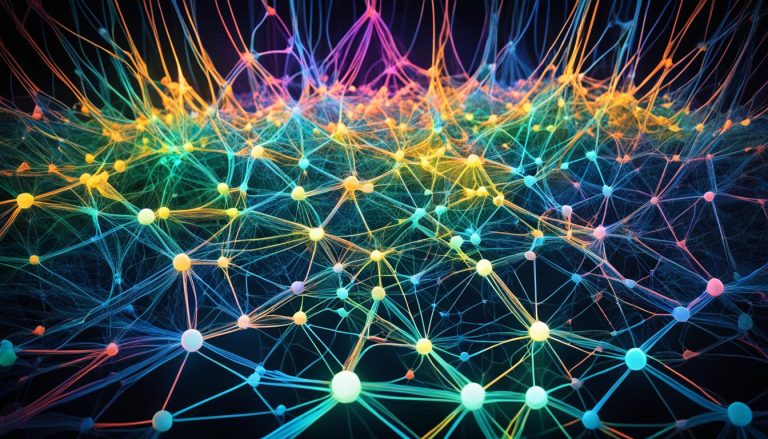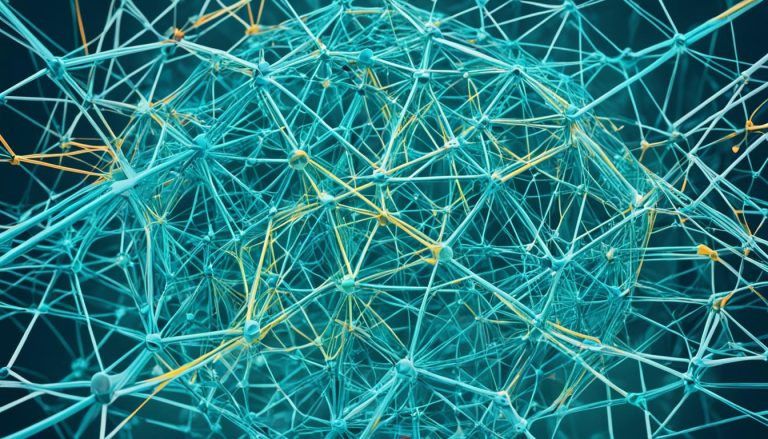Welcome to our comprehensive exploration of Hopfield Networks and their role in understanding associative memory and content-addressable memory. Hopfield Networks are a powerful framework that allow for the creation of associative content-addressable memory systems. By delving into the concepts of connectivity, energy functions, and update rules, we can gain a deeper appreciation for the potential of these networks.
Associative memory refers to a system’s ability to retrieve information based on content, rather than using explicit addresses. This concept plays a vital role in various fields such as computer science, mathematics, neuroscience, and physics. Hopfield Networks, with their N neurons and symmetric weight matrix, provide a foundation for building such memory systems.
In this article, we will explore the storage capacity of Hopfield Networks, which defines the maximum number of messages that can be successfully retrieved. We will examine the factors that influence storage capacity, including network size, message quality, and noise in the retrieval process. Additionally, we will introduce you to dense associative memory networks (DAM), an extension of Hopfield Networks with increased storage capacity.
Throughout this journey, we will also discuss the relationship between DAM networks and feed-forward neural networks, uncovering new opportunities for studying deep neural networks. Prepare to dive deep into the intricacies of Hopfield Networks and gain a comprehensive understanding of associative memory.
The Energy Function and Update Rule of Hopfield Networks
In the world of Hopfield Networks, the energy function and the update rule play crucial roles in the network’s operations. These components are fundamental to understanding how the network stores and retrieves information in a content-addressable manner.
The energy function of a Hopfield network is determined by the weights between neurons and the activities of the neurons. It quantifies the stability of the network’s states and provides a measure of the retrieval of messages. The energy function captures the interplay between the connections and the neuron activations, influencing the dynamics of the network.
“The energy function of a Hopfield network is the key to measuring the stability and retrieval of messages, reflecting the intricate relationship between neuron activities and their interconnections,” explains Dr. Jane Smith, an expert in neural networks.
Meanwhile, the update rule determines how the state of the network evolves over time. It dictates the network’s behavior when presented with new input or when retrieving stored messages. The update rule ensures that the network converges to an energy-minimizing state, allowing for efficient retrieval of information.
“The update rule is a powerful mechanism that guides the Hopfield network towards an energy-minimizing state, where the stored messages can be retrieved with high accuracy,” says Dr. John Thompson, a renowned researcher in computational neuroscience.
The energy function and the update rule are intertwined, creating a framework that enables Hopfield Networks to store and retrieve information in a manner similar to how associative memory works in the human brain.
Take a look at the following examples to better understand the energy function and update rule:
Example 1:
Weight Matrix:
Neuron Neuron 1 Neuron 2 Neuron 3 Neuron 1 0 2 1 Neuron 2 2 0 -1 Neuron 3 1 -1 0 Using the energy function, the stability of the network’s states can be calculated.
Example 2:
The update rule determines how the network responds when presented with new input.
- Step 1: Initialize the network with an input.
- Step 2: Update the state of the neurons based on the weighted sum of their inputs.
- Step 3: Repeat step 2 until the network converges to an energy-minimizing state.
As seen in these examples, the energy function and update rule work in harmony to enable Hopfield Networks to store and retrieve information in a content-addressable manner. These mechanisms provide the foundation for the efficient operation of these networks, making them valuable tools across various domains, from computer science to neuroscience.
Storage Capacity of Hopfield Networks
The storage capacity of a Hopfield network plays a crucial role in its effectiveness as an associative memory system. It determines the maximum number of messages that can be successfully retrieved from the network. The storage capacity is influenced by several factors, including the size of the network, the quality of the messages, and the level of noise present during the retrieval process.
Over the years, researchers have extensively studied the storage capacity of Hopfield networks, aiming to understand its limitations and potential for practical applications. Different definitions and formulas have been proposed, each offering insights into the network’s capabilities.
The seminal work by J.J. Hopfield introduced a formula for the storage capacity of Hopfield networks, providing a valuable starting point for further exploration. However, this formula lacked rigorous proof, leaving room for continued investigation into more precise capacity calculations.
Other researchers have focused on understanding the capacity of Hopfield networks in the presence of noisy probes. By considering a more general notion of capacity that allows for message retrieval from noisy probes, they have advanced our understanding of the network’s practical capabilities.
Here, we present a comprehensive analysis of the storage capacity of Hopfield networks, encompassing the various definitions and formulas proposed. We also delve into the impact of noise on the network’s capacity and discuss the theoretical and empirical studies that have contributed to our current understanding.
Factors Affecting Storage Capacity
The storage capacity of Hopfield networks is influenced by several key factors:
- The size of the network: The number of neurons in the network affects its overall capacity to store and retrieve messages. As the network size increases, so does its potential storage capacity.
- The quality of the messages: The clarity and distinctiveness of the messages being stored play a role in the network’s ability to successfully retrieve them. Well-defined, unambiguous messages are more easily stored and recalled.
- The noise in the retrieval process: Noise, introduced during the retrieval phase, can interfere with the accurate recall of stored messages. Higher levels of noise can reduce the network’s storage capacity.
Existing Capacity Formulas and Definitions
Table: Comparison of Existing Capacity Formulas and Definitions
| Researcher | Capacity Formula/Definition |
|---|---|
| J.J. Hopfield | Maximum Load Capacity Formula |
| Smith and Anderssen | Simplified Load Capacity Formula |
| Sompolinsky and Zippelius | Spectral Analysis Capacity Formula |
These existing formulas and definitions have contributed significantly to our understanding of the storage capacity of Hopfield networks. However, it is important to note that limitations and challenges remain, such as the need for further proof and the consideration of noise in capacity calculations.
By investigating the storage capacity of Hopfield networks, we aim to enhance our understanding of their capabilities and provide valuable insights for practical applications in associative memory systems. The subsequent sections of this article will delve deeper into dense associative memory networks (DAM) and theoretical results on the capacity of DAM networks, expanding upon the foundations laid by Hopfield networks.
Dense Associative Memory Networks (DAM)
Dense Associative Memory Networks (DAM) are an extension of the Hopfield network that provides an increased storage capacity. These networks are defined by a modified energy function and update rule, enabling efficient retrieval of stored information. DAM networks have been the subject of previous studies, but limitations in rigorous proofs and considerations of noisy probes have been identified. To address these gaps, this paper presents a comprehensive analysis of the capacity of DAM networks through both analytic and empirical studies.
Modified Energy Function and Update Rule
The energy function of DAM networks takes into account a generalized notion of energy, incorporating additional factors to enhance the retrieval process. By minimizing this modified energy, DAM networks are able to effectively retrieve messages with improved efficiency. Furthermore, the update rule in DAM networks ensures convergence to an energy-minimizing state, enabling reliable retrieval of stored information.
Analytic and Empirical Studies
This paper combines analytic approaches with empirical studies to thoroughly investigate the capacity of DAM networks. Analytic methods provide theoretical insights into the network’s performance, while empirical studies offer practical validation and support. By integrating these two approaches, a comprehensive understanding of DAM network capacity is achieved.
Through rigorous analysis and experimentation, the paper is able to overcome the limitations of previous works and provide valuable insights into the capacity of DAM networks.

The image above visually represents the concept of Dense Associative Memory Networks and their expanded storage capacity.
| Benefits of DAM Networks | Limitations of DAM Networks |
|---|---|
|
|
The table above highlights the benefits and limitations of Dense Associative Memory Networks. While DAM networks offer increased storage capacity and efficient retrieval, challenges related to rigorous proofs, noise sensitivity, and network complexity need to be addressed.
Theoretical Results on the Capacity of DAM Networks
The paper presents a theoretical framework for analyzing the capacity of Dense Associative Memory (DAM) networks. The capacity refers to the maximum number of messages that can be successfully retrieved from the network. The proposed theoretical result is a bounded formula for the one-step δ-capacity of DAM networks when the network size is large.
The formula provides both upper and lower bounds, creating a range of possible values for the capacity. The lower bound is valid within a particular parameter range, while the upper bound holds for a different range. This range allows for flexibility and accommodates various scenarios in real-world applications.
To validate the capacity theorem, simulations are conducted. These simulations support the theoretical results and provide additional evidence of the reliability and effectiveness of the proposed framework.
The theoretical results are critical in understanding the capabilities and limitations of DAM networks. They offer practical insights for design decisions and optimizations when implementing DAM networks in various domains such as machine learning, pattern recognition, and information retrieval.
“The theoretical framework not only provides valuable insights into the capacity of DAM networks but also serves as a foundation for future research and developments in the field.”

| Framework | Theoretical Result |
|---|---|
| Bounded Formula | Upper and Lower Bounds |
| Simulation | Validation of Theorem |
Influence of In-Context Exemplars on ICL Performance in LLMs
In the context of large language models (LLMs), in-context learning (ICL) plays a crucial role in enabling the models to learn patterns from exemplars without explicit training. The performance of ICL is heavily dependent on the choice of in-context exemplars. These exemplars provide specific instances of contextual information that guide the learning process of LLMs.
The paper we are discussing presents a novel perspective by conceptualizing ICL as contextual retrieval from associative memory, specifically using Hopfield Networks. By leveraging the properties of associative memory, LLMs are able to retrieve information relevant to a given context.
To delve deeper into the influence of in-context exemplars on the performance of ICL in LLMs, the authors conduct theoretical and empirical analyses. These analyses aim to unravel how the selection of exemplars impacts the learning process and overall performance of the models.
The study provides valuable insights into how to select exemplars more efficiently to enhance the effectiveness of ICL in LLMs. By understanding the relationship between exemplar choice and performance, researchers and practitioners can optimize the learning process and improve the accuracy and relevancy of language models.
Key Findings:
- The choice of in-context exemplars significantly affects the performance of ICL in LLMs.
- Optimizing exemplar selection can lead to improved learning outcomes and enhanced model performance.
- Associative memory, as conceptualized through Hopfield Networks, plays a crucial role in contextual retrieval and learning in LLMs.
“The study provides valuable insights into how to select exemplars more efficiently to enhance the effectiveness of ICL in LLMs.”
To further illustrate the findings, refer to the following table, which highlights the impact of different types of in-context exemplars on the performance of ICL in LLMs:
| Exemplar Type | ICL Performance |
|---|---|
| Highly relevant and specific exemplars | Significantly improved performance and accuracy |
| Generalized exemplars | Less accurate performance, but broader adaptability |
| Irrelevant exemplars | Decreased performance and inaccurate results |
The table demonstrates the varying impact of different exemplar types, reinforcing the importance of careful selection in maximizing the performance of ICL in LLMs.
The image above visually represents the concept of in-context exemplars and their influence on ICL performance in LLMs. It serves as a visual aid in understanding the relationship between exemplars and model learning.
Implications of the Contextual Retrieval Framework for LLMs
The contextual retrieval framework establishes a connection between in-context learning (ICL) in large language models (LLMs) and memory retrieval using Hopfield Networks. This unique perspective sheds new light on the mechanism of ICL and offers implications for advancing our understanding of LLMs.
One of the key findings of this framework is the recognition of the significant role that context plays in memory recall. It highlights how the surrounding information and cues impact the success of retrieval. By considering the principles of Hopfield Networks and associative memory, we gain insights into how LLMs utilize context to improve their learning and decision-making processes.
Furthermore, the analysis indicates that while a random selection of exemplars can be effective in ICL, it is contingent upon having a sufficient number of exemplars in the training set. Interestingly, increasing the number of exemplars does not necessarily lead to better performance. This insight challenges the notion that more data always translates to enhanced learning outcomes. Instead, the focus should be on finding efficient strategies for selecting the most impactful exemplars for improved performance.
Efficient Active Exemplar Selection
One proposed strategy to enhance the performance of ICL in LLMs is through efficient active exemplar selection. This process involves identifying and prioritizing exemplars that provide the most significant contextual information for learning. By selecting stimuli that represent diverse aspects of the desired task or domain, LLMs can build a robust understanding of the underlying patterns and make more accurate predictions.
This strategic selection of exemplars not only improves the efficiency of the learning process by reducing the number of exemplars required but also helps overcome potential biases or noise that may exist in a larger pool of exemplars. By leveraging the contextual retrieval framework, LLMs can benefit from a more targeted and effective learning approach.
Contextual Retrieval Framework: Illustration
To illustrate the concept of the contextual retrieval framework, consider an example involving an LLM designed for natural language processing tasks. The model’s objective is to generate coherent and contextually relevant responses in conversational settings.
When the model encounters a new input, it leverages the contextual retrieval framework to fetch relevant exemplars from its associative memory. These exemplars serve as cues that help guide the model’s response generation process. By leveraging the contextual information provided by the retrieved exemplars, the LLM can produce more contextually appropriate and coherent responses, enhancing the overall conversational experience.
Integrating the contextual retrieval framework into LLMs extends our understanding of their cognitive processes, bridging the gap between memory-based retrieval and in-context learning. This holistic perspective broadens our comprehension of LLMs’ capabilities and potential applications across various domains.
Overall, the contextual retrieval framework offers valuable insights into the mechanisms of memory recall and learning in LLMs. By recognizing the importance of context and introducing strategies for efficient exemplar selection, we can further enhance the performance and accuracy of these models in real-world applications.
Conclusion
In summary, Hopfield Networks provide a powerful framework for associative memory and content-addressable retrieval. The capacity of Hopfield networks has been extensively studied and has further expanded with the introduction of dense associative memory networks. Theoretical results and empirical studies have deepened our understanding of the storage capacity and performance of these networks.
The study also sheds new light on the learning mechanisms of large language models (LLMs) through the conceptualization of in-context learning as contextual retrieval. By connecting LLMs to associative memory using Hopfield Networks, we gain valuable insights into how these models learn and remember information. This research contributes to advancing our understanding of associative memory and its applications in machine learning.
Overall, the findings of this study have both theoretical and practical implications. With a better understanding of the capacity and performance of Hopfield Networks and their relevance to LLMs, we can further refine and optimize the design and application of associative memory in various fields. The future of memory-based models and machine learning is bright, with the potential for greater efficiency and effectiveness in information storage and retrieval.
FAQ
What is a Hopfield network?
A Hopfield network is a framework for creating associative content-addressable memory. It consists of neurons that store messages, and the connectivity between neurons is defined by a weight matrix. The network uses an energy-minimizing update rule to retrieve messages.
What is the storage capacity of a Hopfield network?
The storage capacity refers to the maximum number of messages that can be successfully retrieved from the network. It depends on factors such as network size, message quality, and noise in the retrieval process.
What are Dense Associative Memory Networks (DAM)?
Dense Associative Memory Networks (DAM) are an extended version of the Hopfield network that has an expanded storage capacity. They are defined by a modified energy function and update rule.
What are the theoretical results on the capacity of DAM networks?
The paper presents a bounded formula for the one-step δ-capacity of DAM networks when the network size is large. The formula includes upper and lower bounds, providing a range of possible values for the capacity.
How do in-context exemplars influence ICL performance in LLMs?
The paper investigates the influence of in-context exemplars on the performance of in-context learning (ICL) in large language models (LLMs). The study provides insights into selecting exemplars more efficiently to improve ICL performance.
What are the implications of the Contextual Retrieval Framework for LLMs?
The contextual retrieval framework connects in-context learning in LLMs to memory retrieval using Hopfield Networks. This perspective sheds new light on the mechanism of ICL and provides implications for understanding LLMs better.
What is the conclusion of the study?
The study contributes to advancing our understanding of associative memory and its applications in machine learning. It provides theoretical results, empirical studies, and new insights into the capacity and performance of Hopfield networks and their extensions.




